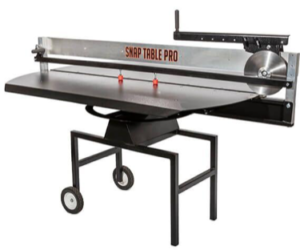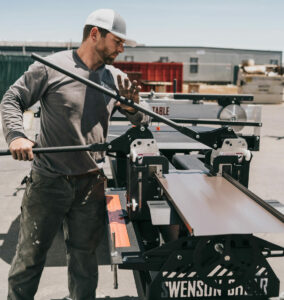August 20, 2024
Posted by: Swenson Shear
What Are the Biggest Metal Roofing Tool Problems (and How to Solve Them)
Metal roofing is steadily gaining popularity due to its longevity, durability, and energy efficiency. However, working with metal requires specialized tools that demand both skill and knowledge. As a roofing contractor, having the right tools is only half the battle. Understanding how to use them effectively, maintain them properly, and choose the right options for specific jobs are keys to success in the metal roofing industry.
Unfortunately, metal roofing tools can bring their own set of concerns and challenges. From worrying about getting a clean, accurate cut to ensuring that your tools are going to last the job, it can be stressful managing this aspect of your work.
In this article, we’ll dive into common concerns about metal roofing tools and provide you with practical solutions. We’ll discuss ways to choose high-quality tools, maintain their peak performance, and ensure your team is equipped to create the best results on any metal roofing project.
Understanding Common Metal Roofing Tool Concerns
As a roofing contractor specializing in metal systems, the tools you use profoundly impact your work’s quality, efficiency, and profitability. Here are the major concerns to keep in mind when it comes to the tools of the trade:
Cut Quality and Cleanliness: The Need for Precision
So, you’ve carefully measured and marked a cut on a sleek metal roofing panel. However, the moment your shear chomps down, the metal distorts, leaving a jagged edge. This uneven cut can create problems that extend far beyond the immediate visual imperfection.
A rough edge creates tiny gaps, undermining the sealing ability of fasteners and making your roof susceptible to leaks. Over time, water intrusion could lead to corrosion, rot in the underlying structure, and potential interior damage. Additionally, burred edges are a safety hazard, posing a risk of cuts to both installers and future maintenance workers.
The frustration with imprecise tools is twofold. Not only does a poor cut compromise the roof’s integrity, but it also creates extra work. You might spend additional time cleaning up the edge, hoping that’s enough, or worse yet, need to replace the entire panel, wasting both time and materials.
Tool Durability and Maintenance: Downtime is the Enemy
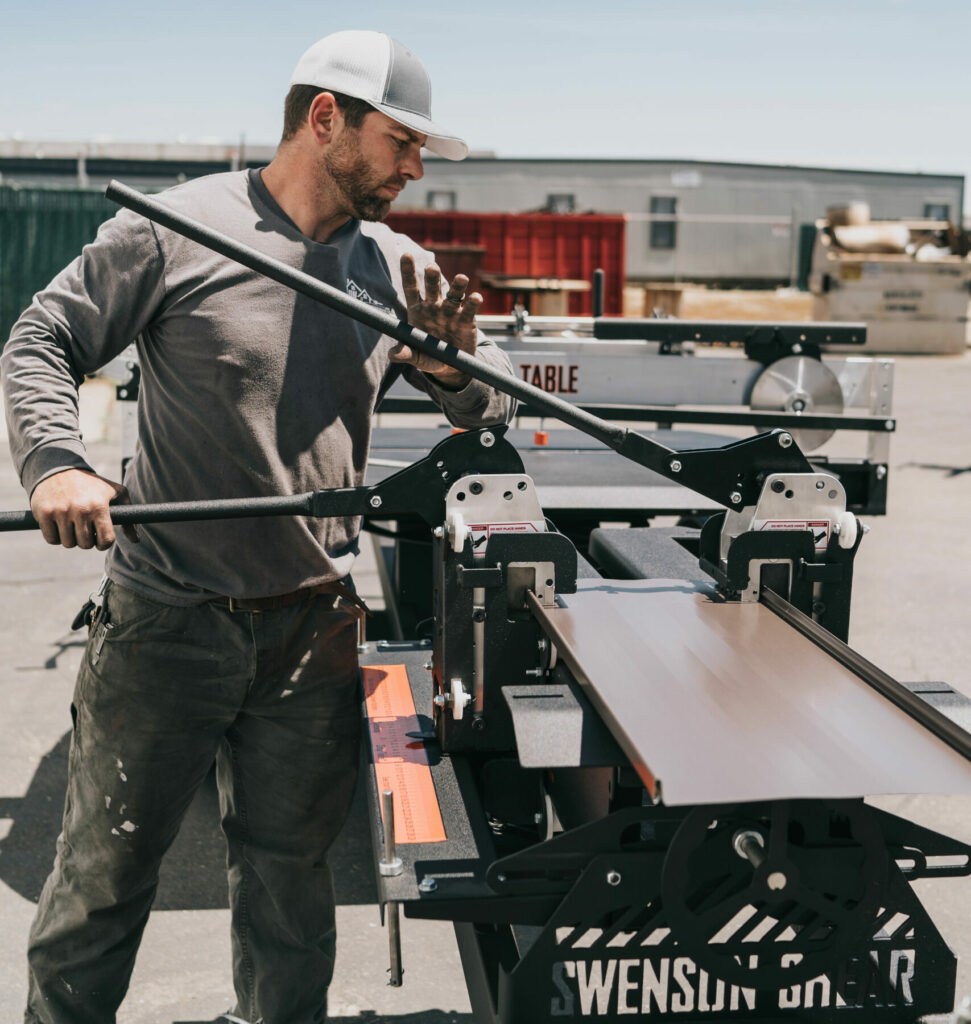
Construction sites aren’t kind to tools. From the rooftop’s blazing heat and potential drops, to jostling around in a truck bed, your metal roofing tools take a beating. A flimsy shear with poor-quality blades might start performing poorly after just a few projects.
A bender with weak tolerances may start producing warped angles. When a tool fails, your entire project grinds to a halt. Finding an emergency replacement becomes your priority, causing delays and headaches.
Beyond outright failure, poorly made tools often require extensive, time-consuming maintenance. If you constantly have to tighten loose bolts, sharpen dull blades, or struggle with sticky mechanisms, it eats into your productivity and adds a layer of frustration to your workflow.
Finding the Right Tool for the Job: Efficiency Matters
Mismatching tools to tasks plagues every workshop. Just imagine trying to cut large, thick metal panels with shears designed for smaller trim work. Not only will it be incredibly slow and physically demanding, but you risk damaging both the material and the undersized tool.
On the other hand, using specialized tools for tasks they’re not designed for compromises work quality. Trying to form crisp bends with general-purpose pliers isn’t going to give you the precise angles you need for a professional-looking job.
The repercussions are lost time, potential material waste, and subpar results. In the worst-case scenario, you might even need to redo work, eroding profits and harming your reputation.

Ease of Use and Ergonomics: When Your Body Pays the Price
Metal roofing is demanding work. Hauling heavy, awkward tools up a ladder, then wrestling with them all day under the sun is grueling.
Poorly designed handles can strain your hands, while excessive tool weight throws off your balance and contributes to fatigue. When tools fight against you rather than working with you, it affects both the quality of your work and your physical wellbeing.
Repetitive, physically demanding motions are already a recipe for strain and potential injury. Add in the additional challenge of cumbersome tools, and the risk to worker safety multiplies. Exhausted workers are more prone to mistakes, potentially leading to accidents with tools or slips and falls from the roof.
Noise Levels: A Nuisance with Consequences
Metal roofing tools emit significant noise. The clanging, cutting, and bending of metal are simply loud by nature. While this might be tolerable on open job sites, in residential areas, excessive noise can quickly lead to complaints from neighbors and potential violations of local ordinances.
Furthermore, prolonged exposure to loud construction noises can damage worker hearing. While hearing protection is mandatory, tools with features designed to minimize sound output provide an additional layer of protection. Noise reduction can also make communication easier on the job site, enhancing coordination and safety.
Cost: Balancing Upfront Investment with Long-Term Value
Quality metal roofing tools represent a significant financial investment for a contractor. It’s understandable to want to minimize these upfront costs, especially when starting out. However, opting for the cheapest tool available can backfire spectacularly. Tools prone to breaking require replacements, while those that perform poorly waste time and materials.
The true long-term cost of a tool goes beyond the initial purchase price. Consider the expenses associated with downtime, rework, and the potential hit to your reputation if you can’t deliver the quality results your clients expect. Investing in durable, well-designed tools might cost a bit more upfront, but ultimately it delivers greater value by streamlining your workflow, minimizing problems, and contributing to successful projects.
Compatibility with Accessories: When Mismatched Tools Undermine Your Work
Imagine meticulously installing a beautiful metal roof, envisioning a finished product that gleams in the sunlight and reflects your expertise. But then comes the frustrating realization: your tools and the fasteners, flashing, or trim you have on hand simply don’t work together. This incompatibility forces clumsy workarounds – using pliers instead of the proper seaming tool, struggling to bend flashing to fit improperly sized panels.
The result? A compromised final outcome that detracts from the sleek, professional appearance you strive for. The frustration with incompatible tools is twofold. Not only do they undermine the visual appeal of the roof by introducing visible gaps or ill-fitting seams, but they also create potential weak points in the roof’s integrity. Incompatibility can lead to leaks, a major concern for any roofing contractor.
Weight and Fatigue: Your Tools Shouldn’t Be the Enemy
Metal roofing work takes place in harsh environments. The sun beats down relentlessly, and a significant portion of the labor involves holding tools overhead for extended periods. Excessively heavy or awkwardly balanced tools quickly become the enemy in these conditions, accelerating exhaustion and putting your crew at risk.
Overly weighty tools strain your workers’ muscles unnecessarily, leading to compromised precision in their cuts and bends. This fatigue contributes to mistakes with tool operation, increasing the likelihood of slips, cuts, or dropped tools that can cause serious on-site injuries. Exhausted workers are more prone to errors in judgment as well, potentially leading to incorrect installation techniques that compromise the roof’s performance.
Adaptability: The Right Tool for Every Situation
Metal roofing projects are rarely one-size-fits-all endeavors. You might encounter panels of differing thicknesses, from delicate trims to thick structural components. Intricate cuts and bends may also be required to navigate around roof features or create custom flashing details. Tools with limited adaptability become a major liability in these scenarios.
Rigid, single-purpose tools force you to waste time improvising solutions, cobbling together workarounds that may not be efficient or effective. This translates to frustration for your crew, potential material waste due to damaged panels from ill-suited cutting tools, and subpar results that fail to meet your high standards for quality and precision.
Availability of Replacement Parts: Don’t Let Breakdowns Stop Your Progress
Even the most rugged tools eventually succumb to wear and tear. A broken part, whether a dull shear blade or a cracked bender arm, can bring an entire project to a standstill. When a component fails, the inability to source a replacement quickly and easily compounds the problem.
Lengthy delays due to the unavailability of parts create headaches and severely disrupt your team’s workflow. Frustration mounts as deadlines loom, and projects fall behind schedule due to a simple failure.
The best tools require minimal maintenance, but even these require occasional part replacements. When choosing your metal roofing tools, consider the ease of obtaining replacements for parts that are prone to wear and tear. This foresight can help you avoid costly delays and keep your projects on track.
Power Supply and Electrical Issues
Metal roofing work involves navigating power cords, generators, and potential disruptions to electrical supply. Prioritize tools with appropriate cord lengths for the working environment, or consider cordless options where feasible. Train your team to identify and avoid trip hazards posed by extension cords. Have a plan in place in the event of a power outage, ensuring you have the backup power or alternative tools necessary to minimize project delays. Understand the proper use of GFCI outlets and other jobsite electrical safety protocols.
Proactive Solutions for Metal Roofing Tool Concerns
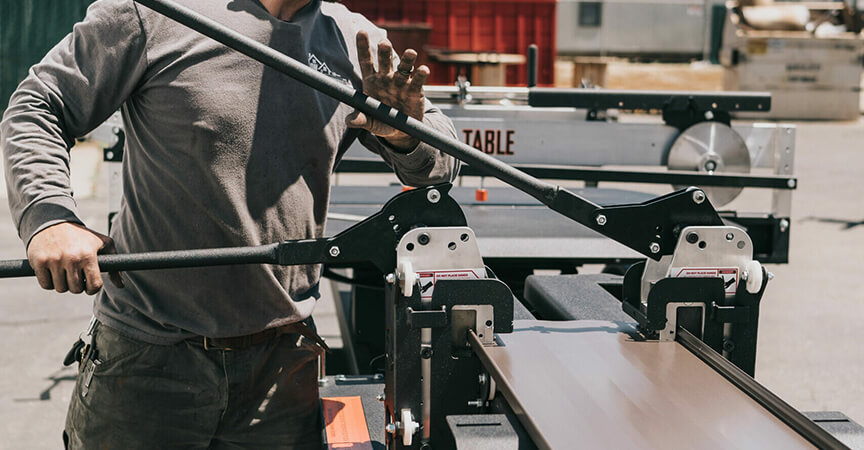
Now that we’ve thoroughly explored the common frustrations contractors encounter with their metal roofing tools, let’s shift focus to proactive solutions. Here’s how to tackle these concerns head-on, ensuring your team has the right tools and support for success:
- Prioritize Compatibility: Before investing in new tools, spend time understanding the full range of materials, fasteners, flashing, and trim components you regularly utilize in your metal roofing projects. Select tools specifically designed to work seamlessly with those components. This proactive approach eliminates mismatched accessories, minimizing on-the-job frustrations and ensuring your installations are both visually stunning and structurally sound.
- Invest in Lightweight, Ergonomic Designs: Seek out tools made from durable yet lightweight materials. Look for features like balanced handles, comfortable grips, and designs that minimize strain on your workers’ bodies. Minimizing unnecessary fatigue translates directly to increased worker safety, improved precision, and a better overall experience for your team.
- Seek Out Adaptable Tools: Versatility is key in metal roofing. Opt for tools with adjustable settings, interchangeable parts, or multi-functional features. This adaptability allows you to handle a wider range of tasks without a cluttered toolbox, saving you both time and money while ensuring you’re always equipped for those unexpected details.
- Emphasize Easy Maintenance and Repair: Look for tools with readily available replacement parts and straightforward maintenance requirements. Consider manufacturers that offer repair guides, online tutorials, or excellent customer support. These resources empower your crew to minimize downtime, extending tool lifespan and keeping your projects moving efficiently.
- Power Planning and Safety: Strategically address your power needs for each job site. Invest in extension cords with ample length and consider backup power options like generators. If cordless tools are a possibility for some tasks, they offer greater flexibility and minimize trip hazards. Train your team in electrical safety protocols, GFCI outlets, and proper handling of tools around power sources.
Beyond these specific solutions, here are additional strategies for success:
- Training and Education: Invest in thorough training for your crew on the proper use and maintenance of each metal roofing tool. This proactive education prevents costly mistakes, protects your tools from damage, and promotes overall worker confidence and skill.
- Partnership with Manufacturers: Build relationships with knowledgeable tool manufacturers. A supportive manufacturer can answer questions, recommend the right tool for a specific job, and become your go-to resource for replacements and troubleshooting.
Selecting the Right Metal Roofing Tool Manufacturer: What to Consider
Your choice of metal roofing tool manufacturer directly impacts your ability to overcome common challenges and find the support you need to excel in your trade. Here’s how to ensure you partner with a supplier who will contribute to your success:
Expertise in Metal Roofing Tools
Seek out manufacturers that either specialize in or have a deep understanding of metal roofing tools. These suppliers possess the in-depth knowledge necessary to troubleshoot problems, recommend the perfect tool for specific jobs, and stay up-to-date on the latest advancements that could benefit your business. They understand the unique demands of metal roofing and can offer tailored solutions.
Reputation and Customer Support
Choosing a reputable supplier is crucial for those moments when something goes wrong with your tools. Talk to other roofing contractors to find out which suppliers prioritize customer support, going above and beyond to ensure their clients have the resources they need. Seek out companies known for their responsiveness, helpfulness, and a focus on resolving issues quickly to minimize downtime for your team.
Range of Products and Brands
A diverse selection empowers you to find the exact tools to streamline your workflow and match your specific projects. A wide range of options allows you to compare features, price points, and functionalities, finding the best match for your individual needs. This ensures you don’t have to compromise due to limited selection.
Educational Resources
Manufacturers that invest in providing guides, tutorials, and other training materials signal a commitment to helping roofing contractors succeed. These resources empower your team, ensuring proper use and maintenance of tools to maximize effectiveness, prevent damage, and extend their lifespan. They become particularly valuable when training new employees or introducing a new tool into your workflow.
Competitive Pricing and Value
While it’s tempting to choose based on lowest price, consider the long-term value. Factor in a supplier’s expertise, their commitment to customer service, warranties offered, and the quality of the tools they carry when evaluating pricing. This holistic approach helps ensure you’re investing in a supplier that supports your goals rather than just offering a quick sale.
Warranties and Return Policies
Understand the warranties from both the manufacturer and the supplier. This knowledge provides peace of mind knowing unexpected repairs or replacements have coverage for a period of time, minimizing the financial impact on your business.
Location and Shipping
For rapid tool replacement needs, consider a supplier’s proximity and their shipping policies. Local suppliers may offer faster delivery or the option for in-person pickup when time is of the essence to keep your projects moving along.
Create a strong relationship with the right tool supplier, and gain a reliable partner in your quest to tackle metal roofing projects with confidence, efficiency, and exceptional results.
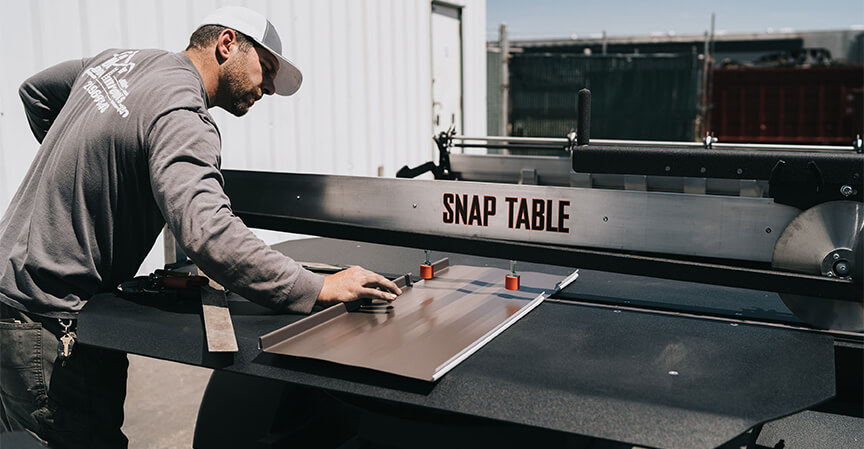
Choosing Your Tools Wisely
Choosing the right tools is less about having the biggest collection and more about having the right tool for each job. Consider these factors when building or expanding your metal roofing tool arsenal:
Material Types and Thicknesses
Metal roofing presents you with materials like steel, aluminum, copper, and more, each with unique properties and a range of thicknesses (gauges). Select cutters, benders, and seamers specifically designed to handle the materials, panel profiles and gauges you work with most consistently.
Using underpowered tools will damage both the tool and your roofing materials, leading to costly setbacks. Swenson Shear offers tools tailored to different materials and gauges, with their blades and mechanisms designed to provide clean cuts and effortless shaping without exceeding the tool’s capabilities.
Panel Profiles
The beauty of metal roofing lies in its variety. From sleek standing seam panels to traditional metal shingles, each profile requires specialized tools. Prioritize tools for the profiles you install most frequently, ensuring you can create precise cuts, crisp bends, and the flawless seams that are a hallmark of high-quality metal roofing. Swenson Shear recognizes this, offering profile-specific shears, notchers, and seamers for exceptional precision and streamlined installation.
Versatility
While specialized tools are essential, a few multi-purpose options can optimize your toolkit. Some shears can handle left, right, and straight cuts, reducing the number of tools your team needs to switch between. Look for multi-functional features that will reduce clutter and make workdays smoother. Swenson Shear incorporates versatility into some of their designs, offering combination or convertible tools to streamline your workflow and reduce the weight of your toolbag.
Scale of Projects
Tailor your tool choices to the size and complexity of projects you most often handle. If residential roofs are your focus, lighter, more maneuverable tools will be invaluable for those intricate details. Large commercial roofs often benefit from power tools or heavy-duty options designed to handle extended use and increased material volumes. Swenson Shear caters to the full spectrum, providing lightweight ergonomic tools for intricate work as well as larger, robust tools built for the demands of big projects.
Team Skill and Needs
Assess your team’s experience and comfort level with various tools. While some specialized tools require training for optimal use, others are designed with user-friendliness in mind. Find the right balance based on your team’s expertise, and provide training opportunities for those wanting to expand their skill set and take full advantage of more complex tools. Swenson Shear understands the importance of ease-of-use, offering options that are both intuitive for beginners and those that unlock additional capabilities for seasoned professionals.
Pro Tip: Reputable tool manufacturers are an invaluable resource when making decisions. Manufacturers specializing in metal roofing cutting tools, like Swenson Shear, have in-depth knowledge about matching tools to materials and profiles, tasks, and project requirements. Plus, our tools do not need electricity.
The Swenson Shear Advantage – Solutions for Your Metal Roofing Tool Concerns
You take pride in the quality of your metal roofing installations. Don’t let the wrong tools hold you back! Upgrade your toolkit to optimize cuts, streamline workflow, and ensure every project reflects your craftsmanship.
Partner with Swenson Shear to discover tools designed with your challenges in mind. Our commitment to precision, durability, and user-friendly innovation makes them a trusted choice for roofing professionals who demand excellence.
Visit the Swenson Shear website or contact our team to start building your ideal metal roofing tool collection. Invest in the right tools and experience the difference quality makes on every project.


